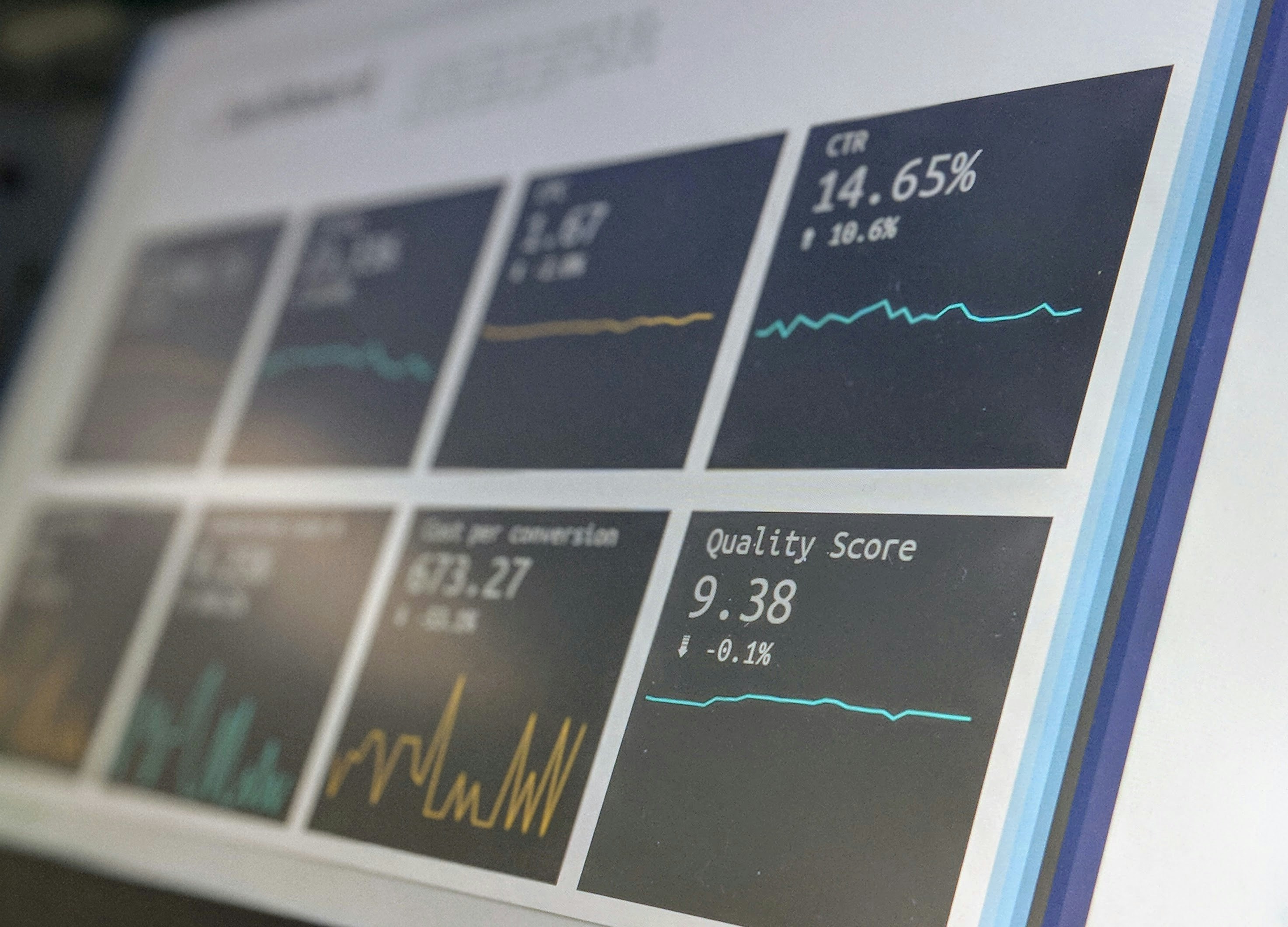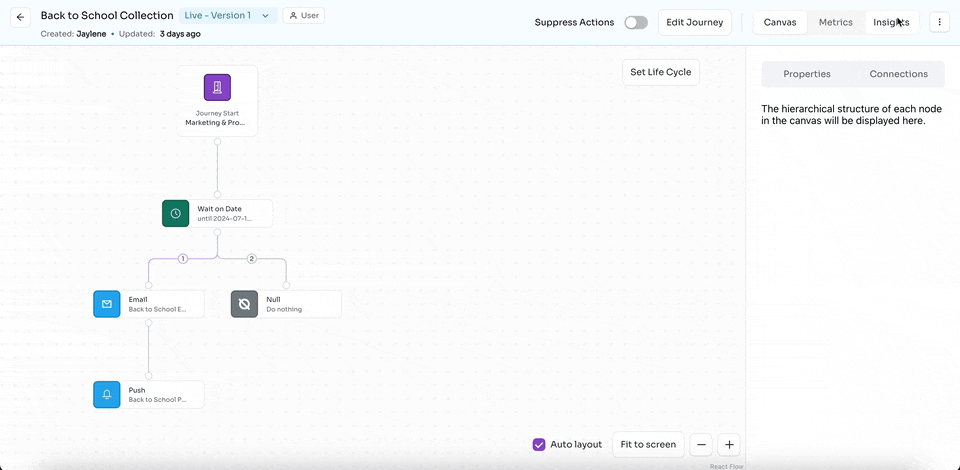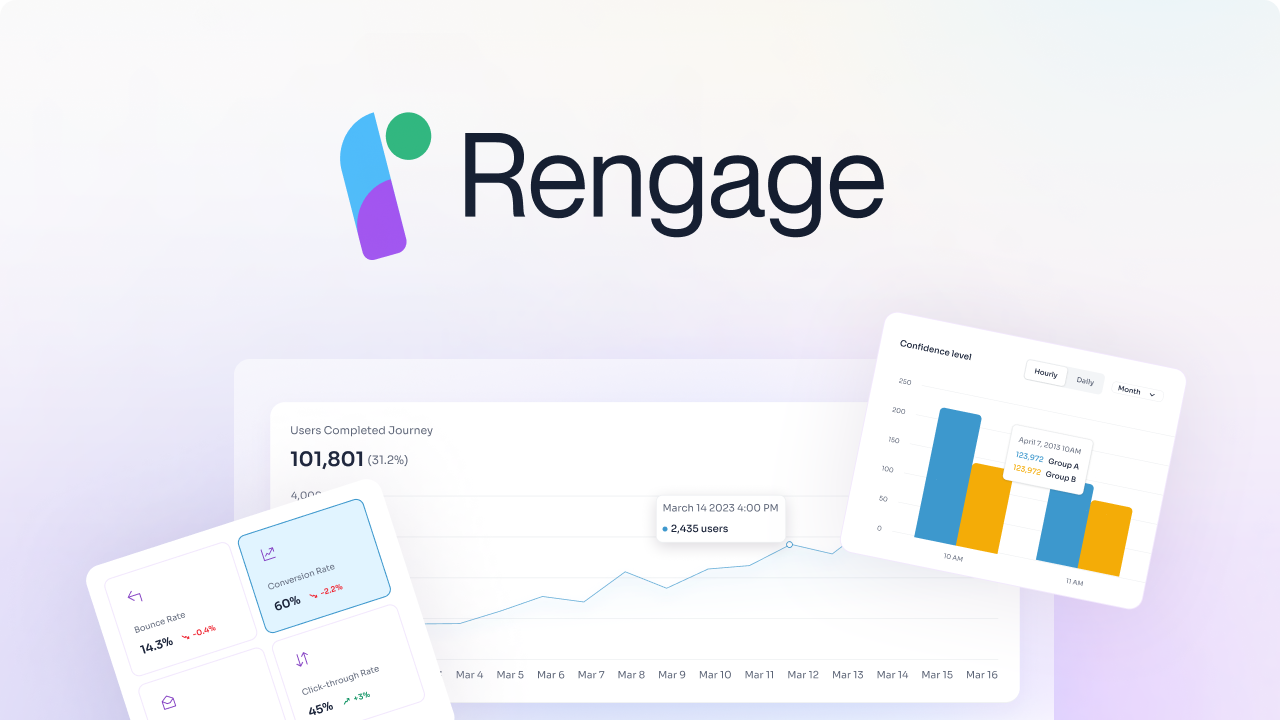Are you ready to overcome the top 14 challenges in omnichannel commerce in 2024 to enhance your omnichannel customer experience? Imagine your business seamlessly engaging with customers across multiple channels, delivering a personalized experience consistently. This article will help you understand omnichannel commerce by exploring the top 15 challenges and offering solutions to each one.
Rengage's omnichannel marketing platform is the perfect tool to help you master omnichannel commerce, ensuring you meet your goals in 2024
Table of Contents
-
What Defines An Effective Omnichannel Strategy?
-
Top Trends Shaping Omnichannel Experiences
-
What Are The Foundational Elements Of A Successful Omnichannel Strategy?
-
How Can Businesses Align Their Resources to Achieve Omnichannel Readiness?
-
How Does Technology Facilitate Seamless Omnichannel Experiences?
-
Top 15 Challenges in Omnichannel Commerce and Solutions
-
Create Personalized Experiences That Drive Loyalty and Growth with Rengage's Omnichannel Marketing Platform
What Defines An Effective Omnichannel Strategy?

A successful omnichannel strategy integrates multiple marketing and sales channels into a:
- United customer experience
- Emphasizing consistency
- Personalization
- Convenience across all touchpoints
Here are the foundational elements that contribute to the effectiveness of an omnichannel strategy:
Unified Customer Experience
At the core of an omnichannel strategy is delivering a unified customer experience. This means that regardless of how and where customers interact with your brand, they should receive:
- Consistent messaging
- Branding
- Service
A unified experience ensures customers feel connected to the brand across different channels, fostering loyalty and trust.
Seamless Integration
Successful omnichannel strategies require seamless integration of various channels and touchpoints. This integration allows for smooth transitions as customers move between online and offline platforms.
For instance, a customer may research a product online, visit a physical store to see it in person, and then complete the purchase via a mobile app. Seamless integration ensures that the customer's journey is uninterrupted and that relevant information is accessible across all channels.
Data-Driven Insights
Data plays a crucial role in optimizing omnichannel strategies. Businesses can gain valuable insights into consumer behavior, preferences, and purchasing patterns by collecting and analyzing customer data from multiple touchpoints. This data allows for:
- Personalized marketing campaigns
- Targeted promotions
- Tailored recommendations that resonate with individual customers
Personalization
Personalization is key to creating meaningful interactions and enhancing customer engagement in an omnichannel environment. By leveraging customer data and behavioral insights, businesses can:
- Deliver personalized content
- Product recommendations
- Offers that are relevant to each individual's preferences and interests.
Consistency Across Channels
Consistency in branding, messaging, and customer service standards is essential for building a strong brand identity and maintaining customer trust. Whether a customer interacts with your brand on social media, through email marketing, or in-store, they should encounter consistent messaging and experiences that reflect the brand's values and promise.
Optimized Customer Journey
An effective omnichannel strategy optimizes the customer journey from awareness to purchase. This involves mapping the customer's path across different touchpoints and identifying opportunities to enhance each interaction.
Real-Time Responsiveness
Omnichannel strategies benefit from real-time responsiveness to customer actions and inquiries. This requires monitoring and responding promptly to customer interactions across various channels, whether addressing a customer query on social media, resolving a complaint via live chat, or sending personalized follow-up emails post-purchase.
Continuous Optimization and Adaptation
Successful omnichannel strategies are dynamic and evolve based on ongoing analysis, feedback, and market trends. Businesses should continuously optimize their strategies by testing new channels, refining messaging, and improving the customer experience based on performance metrics and customer feedback.
Top Trends Shaping Omnichannel Experiences

Customer-Centric Approach
To create a successful omnichannel strategy, businesses must take a customer-centric approach. This approach involves gathering data from various sources to create comprehensive customer profiles. These profiles help:
- Tailor marketing messages
- Product offerings
- Service experiences to meet individual customer expectations
By focusing on delivering value and relevance at every interaction, businesses can enhance customer satisfaction and loyalty.
Seamless Integration Across Channels
Achieving success with an omnichannel strategy requires the seamless integration of all customer-facing channels, including online and offline options. This integration ensures that customers have a consistent experience no matter how they engage with the brand. Integration also enables businesses to track interactions across channels and provides a holistic view of the customer journey.
Data-Driven Insights and Personalization
Data-driven insights are crucial in personalizing the customer experience within an omnichannel framework. By analyzing customer data in real time, businesses can gain valuable insights into purchase history, browsing behavior, preferences, and demographics. This information allows:
- Targeted marketing campaigns
- Personalized recommendations
- Customized promotions that resonate with individual customers
Consistent Branding and Messaging
Consistency in branding and messaging is essential for reinforcing brand identity and building customer trust. They should encounter consistent visuals, tone of voice, and messaging that align with the brand’s values and promise whether:
- A customer interacts with the brand on social media
- Receives an email promotion
- Visits a physical store, or contacts customer support
Optimized Customer Journey Mapping
Mapping the customer journey across all touchpoints helps businesses identify critical interactions and pain points that impact the overall experience. By understanding how customers move through the sales funnel—from awareness and consideration to purchase and post-purchase support—businesses can optimize each stage to minimize friction and maximize satisfaction.
Operational Alignment and Collaboration
Successful omnichannel strategies require alignment across departments and functions within the organization. Marketing, sales, customer service, IT, and operations teams must collaborate closely to ensure seamless execution of omnichannel initiatives. This collaboration involves:
- Sharing data
- Coordinating campaigns
- Aligning processes
Technology and Infrastructure
Robust technology infrastructure is foundational for supporting an omnichannel strategy. This includes:
- Integrated CRM systems
- Advanced analytics tools
- Marketing automation platforms
- Cloud-based solutions
Investing in scalable and agile technology ensures businesses can adapt to evolving customer expectations and market trends.
Continuous Improvement and Adaptation
Omnichannel strategies are dynamic and require continuous monitoring, evaluation, and adaptation. Businesses should regularly analyze performance metrics, customer feedback, and market trends to identify areas for improvement and innovation. This iterative approach allows businesses to:
- Refine their strategies
- Test new initiatives
- Respond swiftly to changes in consumer behavior or the competitive landscape.
What Are The Foundational Elements Of A Successful Omnichannel Strategy?

1. Frictionless Transactions and Convenience
Customers crave speed and ease. Trends like tap-to-pay options, mobile wallets, and "buy online, pick up in-store" (BOPIS) are becoming mainstream. Offering a variety of convenient payment methods and flexible fulfillment options streamlines the customer journey and removes friction from the buying process.
2. The Rise of Voice Commerce and Conversational AI
Voice assistants like Alexa and Google Assistant are increasingly used for shopping. Omnichannel strategies that integrate voice ordering or chatbots with AI capabilities can provide:
- Personalized recommendations
- Answer product questions
- Facilitate a more conversational shopping experience
3. The Power of Personalization
Customers expect brands to know them and cater to their individual needs. Omnichannel strategies that leverage customer data across channels can personalize product recommendations, marketing messages, and offers. This tailored approach fosters loyalty and increases conversion rates.
Augmented reality (AR) and virtual reality (VR) technologies are finding their way into omnichannel experiences. AR apps can allow virtual product try-on or placement in a customer's home, while VR can create immersive shopping environments. These technologies can bridge the gap between online and offline shopping and provide a more engaging experience.
5. Social Commerce and the Rise of Influencers
Social media platforms are evolving into powerful shopping channels. Brands are leveraging influencer marketing and integrating social media shopping features to reach customers where they spend their time. Omnichannel strategies that connect social media browsing with purchase opportunities can be highly effective.
6. Prioritizing Sustainability and Ethical Practices
Consumers are increasingly concerned about environmental and social responsibility. Omnichannel strategies resonate with environmentally conscious customers that:
- Promote sustainable packaging options
- Transparent supply chains
- Ethical labor practices
7. Focus on Building Trust and Transparency
Data privacy is a major concern. Omnichannel strategies that prioritize data security, transparent data collection practices, and clear communication about how customer information is used can build trust and loyalty.
8. The Evolving Role of Physical Stores
While online shopping continues to grow, physical stores remain crucial for the omnichannel experience. The trend is shifting towards stores becoming experience centers, offering product demonstrations, personalized advice, and click-and-collect options.
9. The Importance of Data-Driven Insights and Measurement
Omnichannel strategies thrive on data. Measuring customer behavior across channels, tracking key metrics, and analyzing customer feedback allows for continuous improvement and the optimization of the overall omnichannel experience.
By staying on top of these trends and implementing them strategically, businesses can create an engaging omnichannel experience that keeps customers happy and coming back for more. The future of omnichannel retail lies in offering a unified journey that integrates the best of online and offline experiences.
How Can Businesses Align Their Resources to Achieve Omnichannel Readiness?

Establish Clear Objectives and Strategy
Start by defining clear objectives for your omnichannel strategy. Identify specific goals such as:
- Improving customer experience
- Increasing sales conversion rates
- Enhancing brand loyalty
- Expanding market reach
Develop a comprehensive strategy that outlines how you will integrate various sales and marketing channels to achieve these objectives. Ensure alignment with overall business goals and secure buy-in from key stakeholders across departments.
Invest in Technology Infrastructure
Building a robust technology infrastructure is essential for supporting omnichannel operations. Invest in a scalable and integrated digital platform or Customer Data Platform (CDP) that consolidates customer data from multiple touchpoints. This infrastructure should enable:
- Seamless data synchronization
- Real-time analytics
- Personalized customer interactions across channels
Choose technologies that support APIs for easy integration with existing systems and third-party applications.
Adopt Unified Customer Data Management
Centralize customer data management to better understand customer behaviors, preferences, and interactions across channels. Implement a unified Customer Relationship Management (CRM) system or CDP that aggregates data from:
- Online stores
- Mobile apps
- Social media platforms
- Physical stores
- Customer service interactions
This unified data approach facilitates personalized marketing campaigns, targeted promotions, and consistent messaging based on individual customer profiles.
Enhance Cross-Functional Collaboration
- Achieving omnichannel readiness requires collaboration across marketing, sales, IT, customer service, and supply chain management departments.
- Foster a culture of collaboration and communication to ensure alignment of goals, strategies, and resources.
- Establish cross-functional teams dedicated to omnichannel initiatives, with representatives from each department working together to streamline processes and optimize customer experiences.
Optimize Inventory and Supply Chain Management
- Align inventory and supply chain management processes to support omnichannel fulfillment strategies.
- Implement inventory visibility tools that provide real-time insights into stock levels across all sales channels.
- Adopt a unified order management system (OMS) that enables seamless order routing, inventory allocation, and fulfillment from warehouses, distribution centers, and retail stores.
- This integration ensures efficient order processing, reduces out-of-stock situations, and enhances customer satisfaction with timely deliveries.
Implement Seamless Payment and Checkout Experiences
- Simplify payment and checkout experiences to reduce friction and enhance conversion rates across channels.
- Implement a unified payment gateway that supports various payment methods and currencies, ensuring a seamless transaction process for customers shopping online, via mobile apps, or in-store.
- Enable features such as saved payment options, one-click checkout, and secure payment processing to streamline the purchasing journey and increase customer satisfaction.
Enable Omnichannel Customer Service
- Deliver consistent and responsive customer service across all channels to enhance the overall shopping experience.
- Implement an omnichannel customer service strategy that integrates live chat, email support, social media interactions, and telephone inquiries.
- Provide customer service agents with access to unified customer profiles and interaction histories to deliver personalized assistance and resolve issues efficiently.
- Implement automated chatbots and AI-powered assistants to handle common inquiries and provide 24/7 support.
- Define key performance indicators (KPIs) to measure the success of your omnichannel initiatives.
- Track metrics such as customer lifetime value, conversion rates by channel, average order value, customer retention rates, and Net Promoter Score (NPS).
- Use analytics tools and dashboards to monitor KPIs in real-time and identify areas for improvement.
- Continuously analyze customer feedback, sales data, and behavioral analytics to refine your omnichannel strategy and optimize resource allocation.
Continuously Adapt and Innovate
Omnichannel readiness is an ongoing process that requires agility and adaptability to respond to changing market trends and consumer preferences. Stay informed about:
- Emerging technologies
- Industry best practices
- Competitive benchmarks
Foster a culture of innovation within your organization by encouraging experimentation with new channels, technologies, and customer engagement tactics. Regularly update your omnichannel strategy based on performance insights and market dynamics to maintain relevance and sustain competitive advantage.
How Does Technology Facilitate Seamless Omnichannel Experiences?

1. Integration of Customer Data
Technology enables businesses to consolidate customer data from multiple touchpoints, including:
- Online stores
- Mobile apps
- Social media platforms
- Physical stores
- Customer service interactions
Customer Data Platforms (CDPs) and unified Customer Relationship Management (CRM) systems play a crucial role in aggregating and synchronizing data in real-time. This integration allows businesses to gain a view of each customer’s preferences, behaviors, purchase history, and interactions across channels, enabling personalized marketing strategies and tailored customer experiences.
Advanced technology solutions provide Unified Commerce Platforms (UCPs) that integrate all sales channels—online, offline, mobile, and social media—into a single platform. UCPs streamline inventory management, order processing, and fulfillment operations across channels, ensuring consistent product availability and seamless customer service.
These platforms facilitate centralized control over pricing, promotions, and customer communications, enhancing operational efficiency and reducing complexity for businesses aiming to deliver unified shopping experiences.
3. Real-Time Analytics and Insights
Technology enables businesses to leverage real-time analytics and predictive insights to optimize omnichannel strategies. Analytics tools monitor customer interactions, sales trends, and inventory levels across channels, providing actionable data for decision-making. Machine learning algorithms analyze vast datasets to:
- Forecast demand
- Personalize product recommendations
- Automate marketing campaigns based on customer behavior and preferences
Real-time insights empower businesses to respond swiftly to market dynamics, identify opportunities for cross-selling and upselling, and enhance the overall customer experience.
4. Seamless Customer Engagement
Digital technologies such as Artificial Intelligence (AI), chatbots, and Virtual Assistants (VAs) play a pivotal role in enhancing customer engagement across omnichannel touchpoints. AI-powered chatbots provide:
- Instant responses to customer inquiries
- Recommend products
- Guide users through the purchasing journey
VAs offer personalized assistance, voice-enabled shopping experiences, and proactive customer service via voice commands and natural language processing (NLP). These technologies ensure consistent, timely, and interactive customer engagement, driving satisfaction and loyalty.
5. Mobile Optimization and Connectivity
Mobile technology is integral to omnichannel strategies, as a growing number of consumers use smartphones and tablets for shopping. Mobile-optimized websites, responsive design, and mobile apps enable:
- Seamless browsing
- Product search
- Checkout experiences across devices
Mobile wallets and contactless payment options further enhance convenience and speed up transactions in-store and online. Leveraging location-based services and push notifications, businesses can:
- Deliver targeted promotions
- Personalized offers
- Location-specific content to engage customers in real-time
6. IoT and Connected Devices
The Internet of Things (IoT) facilitates omnichannel experiences by connecting physical objects and devices to the internet, enabling data exchange and automation. IoT-enabled devices such as smart mirrors, interactive displays, and wearable technology enhance in-store experiences by providing:
- Product information
- Personalized recommendations
- Virtual try-on capabilities
IoT sensors track inventory levels, monitor store traffic patterns, and optimize store layouts for better customer navigation and product accessibility. Businesses create immersive and personalized shopping environments by integrating IoT with digital platforms, blending physical and digital interactions.
7. Omnichannel Customer Service
Technology empowers businesses to deliver omnichannel customer service that meets consumer expectations for immediate support and assistance. Integrated communication channels such as live chat, email, social media, and telephone enable customers to contact support teams conveniently from any channel.
CRM systems and service management platforms unify customer interactions, ensuring a consistent service experience across touchpoints. AI-driven service bots handle routine inquiries, escalate complex issues to human agents, and maintain continuity in customer conversations across channels, enhancing satisfaction and resolving issues promptly.
8. Security and Data Privacy
Maintaining robust cybersecurity measures and adhering to data privacy regulations enable secure omnichannel experiences. Customer transactions and sensitive information are protected across digital channels, such as:
- Secure payment gateways
- Encryption technologies
- Fraud detection systems
Compliance with data protection laws such as GDPR and CCPA builds trust with customers by ensuring their personal data is handled responsibly and transparently. By prioritizing security and privacy, businesses safeguard customer trust and loyalty while facilitating seamless and secure omnichannel interactions.
No-Code Customer Journey Orchestration
We provide a comprehensive solution for managing and enhancing customer journeys, delivering insights and measurable outcomes with no code. We accelerate your customer journey from onboarding, activation to conversion and churn. Enabling customers to unlock revenue from their existing user.
With [Rengage]https://rengage.ai), you can get insights into your segments, run campaigns with an intuitive journey manager, and get insights to measure how your journeys impact users conversion through our Journey Moments and Journey Builder features.
- Journey Moments: insights into your micro-segments
- Journey Builder: intuitive multi-channel marketing automation
- Insights prediction and attribution.
Book a free demo to transform customer interactions into personalized experiences that drive loyalty and growth with our omnichannel marketing platform.
Top 14 Challenges in Omnichannel Commerce and Solutions

1. Seamless Integration of Channels
Seamless integration of online and offline channels is crucial for providing a cohesive customer experience. Customers expect consistency and continuity as they interact with a brand across different touchpoints. A seamless integration ensures that data, messaging, and service levels remain consistent, regardless of how and where customers engage with the brand.
Strategies for integrating online and offline channels effectively:
Unified Customer Profiles
Integrate customer data from all channels into a centralized database to create unified customer profiles. This allows businesses to understand customer behavior holistically and deliver personalized experiences.
Cross-Channel Communication
Implement systems that enable real-time data sharing and communication between online and offline channels. For example, CRM systems can be used to sync data instantly across all touchpoints.
Omnichannel Technology Stack
Invest in integrated technology solutions that support omnichannel operations, such as CRM platforms, inventory management systems, and analytics tools that provide a unified view of customer interactions.
Case studies of successful integration:
Starbucks
Starbucks integrates its mobile app with its physical stores seamlessly. Customers can order ahead on the app, pay online, and pick up their order in-store without any disruption in service or experience.
Nike
Nike's omnichannel strategy allows customers to shop online, visit physical stores for try-ons, and seamlessly switch between channels. Their mobile app and loyalty program bridge the gap between online browsing and in-store purchases.
2. Consistent Brand Messaging
Consistent brand messaging builds brand trust and recognition. It ensures customers receive a unified brand experience across all channels, reinforcing brand values and promises. Inconsistencies in messaging can confuse customers and weaken brand identity.
Techniques for maintaining brand consistency across channels:
Brand Style Guide
Develop and enforce a comprehensive brand style guide that outlines brand voice, tone, visual identity, and messaging guidelines for all channels.
3. Data Management and Utilization
Data silos and fragmented customer data hinder a unified view of customer interactions and preferences. This can lead to inconsistencies in customer service and missed opportunities for personalization and targeted marketing.
Best practices for centralized data management:
Integrated CRM Systems
Implement CRM systems that consolidate data from all channels into a centralized repository. This provides a unified view of customer interactions and facilitates personalized communication and service.
Use data integration platforms to connect disparate systems and ensure seamless data flow across departments and channels.
Data Governance Policies
Establish data governance policies to maintain data quality, security, and compliance with regulatory requirements. Regular audits and data cleansing processes help ensure data accuracy and reliability.
Leveraging data analytics for actionable insights:
Predictive Analytics
Utilize predictive analytics to forecast customer behavior, identify trends, and anticipate future needs. This enables proactive decision-making and personalized customer interactions.
Customer Segmentation
Segment customers based on behavior, demographics, and preferences to tailor marketing campaigns and offers effectively.
Real-time Reporting and Dashboards
Implement real-time reporting tools and dashboards to monitor key performance indicators (KPIs) and track the impact of marketing initiatives across channels.
4. Inventory Management and Fulfillment
Managing inventory across online and offline channels involves challenges such as inventory visibility, demand forecasting, and order fulfillment synchronization. Inaccurate inventory management can lead to stockouts, overstocking, and poor customer experience.
Solutions for optimizing inventory and fulfillment processes:
Inventory Management Systems
Implement robust inventory management systems that provide real-time visibility into inventory levels across all channels. This helps optimize stock allocation and minimize stockouts.
Order Management Systems (OMS)
OMS platforms streamline order processing and fulfillment, enabling efficient order routing and inventory replenishment.
Click-and-Collect Services
Offer click-and-collect options that allow customers to purchase online and pick up orders at nearby physical stores, reducing shipping costs and improving convenience.
Examples of retailers with effective inventory management strategies:
Amazon
Amazon utilizes sophisticated algorithms and predictive analytics to forecast demand and manage inventory across its extensive network of fulfillment centers.
Zara
Zara employs a fast-fashion model with centralized inventory management, enabling rapid replenishment and responsiveness to market trends.
5. Customer Experience Consistency
Consistency in customer experiences builds trust and loyalty. Inconsistent experiences can lead to customer confusion and frustration, affecting brand perception and customer retention.
Strategies for monitoring and improving customer satisfaction:
Customer Journey Mapping
Map out customer journeys across all touchpoints to identify pain points and areas for improvement.
Feedback and Surveys
Collect feedback through surveys, reviews, and customer support interactions to understand customer sentiment and identify opportunities for enhancement.
Service Level Agreements (SLAs)
Establish SLAs for customer service delivery to ensure consistent response times and service quality across channels.
Role of customer feedback and surveys in enhancing CX:
Use NPS surveys to measure customer loyalty and satisfaction levels. Analyze feedback to identify promoters, detractors, and areas for improvement.
Voice of Customer (VoC) Programs
Implement VoC programs to capture customer preferences, expectations, and pain points across all touchpoints.
6. Cross-Channel Marketing Coordination
Coordinating marketing efforts across multiple channels involves challenges related to message consistency, timing, and audience segmentation. Ineffective coordination can result in message fatigue and disjointed customer experiences.
Tools and platforms for coordinating marketing efforts:
Use marketing automation tools to schedule, personalize, and track marketing campaigns across channels. Automation ensures consistent messaging and timing.
CDPs consolidate customer data from various sources to create unified customer profiles. They enable targeted segmentation and personalized messaging across channels.
Content Calendar Tools
Implement content calendar tools to plan and manage marketing content, ensuring alignment with overall marketing strategies and initiatives.
Successful cross-channel marketing campaign examples:
Coca-Cola: Coca-Cola integrates its global marketing campaigns across TV, digital, and social media channels while maintaining a consistent brand message and theme.
Airbnb
Airbnb uses personalized email marketing, social media promotions, and content marketing to engage customers throughout their travel journey and ensure a cohesive brand experience.
7. Omnichannel Attribution and ROI Measurement
Attributing sales and measuring ROI in omnichannel environments is complex due to multiple touchpoints and customer interactions. Traditional attribution models may not capture the full impact of omnichannel marketing efforts.
Methods for measuring omnichannel marketing effectiveness:
Multi-Touch Attribution (MTA)
Use MTA models to assign credit to multiple touchpoints along the customer journey, considering online and offline interactions.
Customer Lifetime Value (CLV)
Calculate CLV to understand the long-term impact of marketing investments on customer retention and profitability.
Marketing Mix Modeling (MMM)
MMM analyzes historical data to quantify the contribution of each marketing channel to sales and ROI, providing insights for future budget allocation.
Tools and metrics for tracking ROI and attribution:
Google Analytics
Google Analytics offers multi-channel funnels and attribution reports to track customer journeys and attribute conversions across channels.
Many automation platforms provide built-in attribution tools to measure the effectiveness of campaigns and channels in driving conversions.
Custom Dashboards
Create custom dashboards using business intelligence tools to visualize and analyze marketing performance metrics, ROI, and attribution data.
8. Technology Integration and Adaptation
Integrating new technologies into existing IT infrastructure involves challenges such as compatibility issues, data migration, and training requirements. Legacy systems may not support modern technologies, requiring upgrades or replacements.
Strategies for adopting and integrating emerging technologies:
Pilot Testing
Conduct pilot tests to evaluate the feasibility and impact of new technologies on business operations before full-scale implementation.
Agile Development
Adopt agile development methodologies to incrementally integrate and adapt technologies, allowing for iterative improvements and feedback.
Training and Upskilling
Provide training and upskilling programs to equip employees with the knowledge and skills needed to leverage new technologies effectively.
Case studies of successful technology integrations:
Netflix
Netflix successfully integrated machine learning algorithms into its recommendation engine to personalize content recommendations based on viewer preferences.
Uber
Uber uses real-time data analytics and geolocation technologies to optimize driver routes, match riders with drivers, and improve overall service efficiency.
9. Regulatory Compliance Across Channels
Omnichannel strategies must adhere to GDPR, CCPA, and PCI-DSS regulations to protect customer data privacy and ensure legal compliance. Non-compliance can result in fines, legal liabilities, and reputational damage.
Best practices for maintaining regulatory compliance in omnichannel:
Data Encryption and Security
Implement robust data encryption protocols and security measures to protect customer information from unauthorized access or breaches.
Transparency and Consent
Obtain explicit consent from customers before collecting and processing their personal data. Provide clear information about data usage and rights.
Audit and Monitoring
Conduct regular audits and monitoring of data practices to ensure compliance with regulatory requirements and industry standards.
Examples of companies handling regulatory challenges effectively:
Apple
Apple prioritizes user privacy and data security across its ecosystem, implementing stringent measures to protect customer data and comply with global privacy regulations.
Salesforce
Salesforce adheres to GDPR and other data privacy regulations, providing customers with tools and resources to manage and protect their data within Salesforce applications.
10. Mobile Optimization and User Experience
Mobile devices play a significant role in omnichannel interactions. A growing number of customers use smartphones and tablets for browsing, shopping, and communication. Optimizing mobile channels enhances user experience and engagement.
Techniques for optimizing mobile channels for better user experience:
Responsive Design
Implement responsive web design that adapts to different screen sizes and devices, providing a seamless browsing and shopping experience.
Mobile Apps
Develop user-friendly mobile apps that offer personalized content, push notifications, and streamlined checkout processes.
Fast Loading Times
Optimize page load speeds and reduce latency to enhance user experience and minimize bounce rates.
Mobile-first design principles and case studies:
Amazon
Amazon's mobile app offers a user-friendly interface, personalized recommendations, and one-click purchasing, optimizing the mobile shopping experience for convenience and efficiency.
Starbucks
Starbucks' mobile app allows customers to order ahead, pay with their mobile devices, and earn rewards seamlessly across its global network of stores, enhancing user engagement and loyalty.
11. Supply Chain Visibility and Transparency
Managing supply chain operations across multiple channels requires real-time visibility into inventory levels, order status, and logistics. Limited visibility can lead to inefficiencies, delays, and increased costs.
Solutions for improving supply chain transparency:
Blockchain Technology
Implement blockchain technology to create a transparent and immutable ledger of supply chain transactions, enhancing visibility and traceability.
IoT Sensors
Use IoT sensors to track inventory in real-time, monitor environmental conditions, and optimize logistics and distribution processes.
Supplier Collaboration:
Foster collaboration with suppliers and logistics partners to share data, coordinate shipments, and improve supply chain efficiency.
Impact of blockchain and IoT in enhancing supply chain visibility:
Walmart
Walmart uses blockchain to track food products from farm to shelf, ensuring food safety and enhancing supply chain transparency.
Maersk: Maersk utilizes IoT sensors and blockchain to monitor container shipments, streamline logistics operations, and provide real-time visibility into cargo movements.
12. Omnichannel Pricing Strategy
Maintaining consistent pricing across online and offline channels while accounting for regional differences, promotions, and discounts is challenging. Inconsistent pricing can confuse customers and erode brand trust.
Strategies for implementing effective omnichannel pricing strategies:
Dynamic Pricing
Implement dynamic pricing strategies that adjust prices in real-time based on demand, competitor pricing, and customer behavior.
Price Matching Policies
Offer price matching policies to ensure consistency across channels and address customer concerns about price discrepancies.
Align promotional campaigns and discounts across online and offline channels to maintain pricing integrity and customer trust.
Pricing intelligence tools and competitive analysis:
PriceSpider
PriceSpider provides pricing intelligence and competitive analysis tools to monitor competitor prices, analyze market trends, and optimize pricing strategies.
Competera
Competera offers AI-driven pricing optimization solutions that enable retailers to set competitive prices, maximize profitability, and enhance customer satisfaction.
13. Employee Training and Adaptation
Employees need training to understand omnichannel strategies, technologies, and customer service standards. Lack of training can lead to inconsistent service delivery and operational inefficiencies.
Methods for educating and empowering employees for omnichannel success:
Comprehensive Training Programs
Develop comprehensive training programs that cover omnichannel concepts, technology usage, customer engagement techniques, and brand guidelines.
Role-Specific Training
Provide role-specific training for sales associates, customer service representatives, and marketing teams to ensure alignment with omnichannel objectives.
Continuous Learning
Foster a continuous learning and development culture through workshops, webinars, and certifications to keep employees updated on industry trends and best practices.
Examples of companies investing in employee training for omnichannel:
Best Buy
Best Buy invests in extensive training programs for its employees to understand omnichannel retailing, customer service excellence, and product knowledge.
Disney
Disney emphasizes employee training and development to deliver magical guest experiences across its theme parks, resorts, and online platforms.
14. Continuous Adaptation to Market Changes
Consumer preferences, market trends, and competitive landscapes constantly evolve, requiring businesses to adapt their omnichannel strategies and offerings accordingly. Failure to adapt can result in missed opportunities and loss of market share.
Strategies for agile and adaptive omnichannel:
Market Research and Analysis
Conduct regular market research and analysis to identify emerging trends, consumer preferences, and competitive threats.
Agile Methodologies
Adopt agile methodologies to quickly iterate and adapt omnichannel strategies based on market feedback, customer insights, and performance metrics.
Collaboration and Innovation: Foster collaboration across departments to brainstorm ideas, experiment with new approaches, and innovate solutions that meet evolving customer needs.
Case studies of brands successfully adapting to market changes:
Netflix
Netflix continuously evolves its content strategy and user interface based on viewer preferences and viewing habits, staying ahead of competitors in the streaming industry.
Tesla
Tesla adapts its sales and marketing strategies to reflect changing consumer attitudes toward electric vehicles, leveraging digital platforms and direct sales models to reach a global audience.
Centralized Content Management
Use centralized content management systems (CMS) to ensure that all marketing collateral, including social media posts, emails, website content, and advertisements, follow to brand guidelines.
Training and Guidelines
Provide training to marketing and customer service teams on brand messaging and guidelines. Regularly update teams on brand updates and ensure adherence to brand standards across all customer interactions.
Rengage 's comprehensive solution brings a fresh approach to managing and enhancing customer journeys. By leveraging this innovative platform, businesses can gain valuable insights and achieve measurable outcomes without the need for complex coding. Rengage effectively accelerates the customer journey from onboarding and activation to conversion and churn, enabling companies to unlock additional revenue from their existing user base.
Insights and Measurable Outcomes
With Rengage, businesses can dive deep into their customer segments, running targeted campaigns through an intuitive journey manager. This allows for a more personalized approach to customer interactions, creating a seamless experience across various touchpoints.
Rengage's journey moments feature provides insights into micro-segments, empowering businesses to make informed decisions based on real-time data. By leveraging the journey builder, companies can easily automate multi-channel marketing efforts, saving time and resources while boosting engagement.
Driving Loyalty and Growth
By using Rengage's omnichannel marketing platform, companies can transform customer interactions into personalized experiences that foster loyalty and drive growth. The platform's insights prediction and attribution features provide a vital understanding of how customer journeys impact conversion rates, helping businesses optimize their strategies for maximum impact. Are you ready to embark on a journey towards enhanced customer engagement and revenue generation?
Book a free demo with Rengage today to get started.


















































